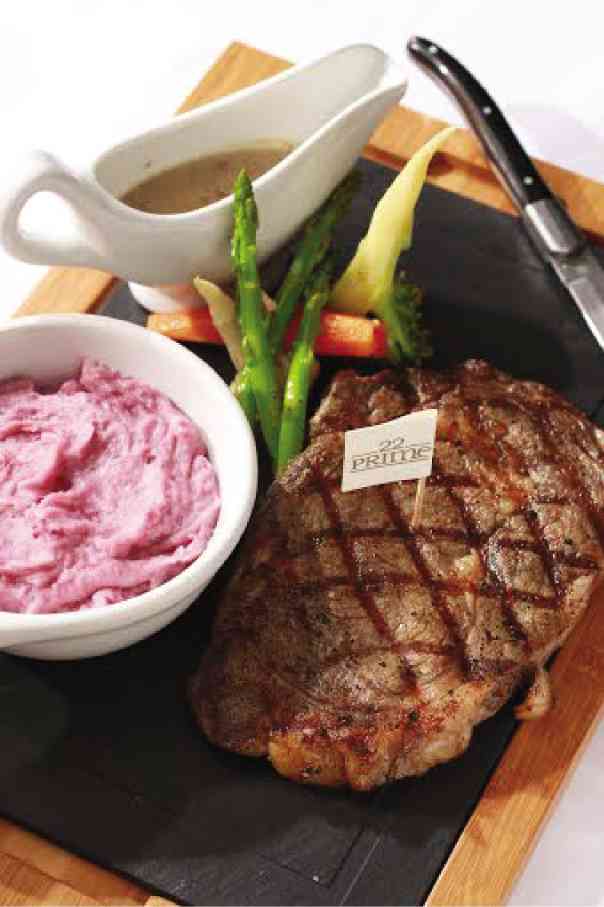
Steak may appear easy to cook, but it is really difficult to make perfect. The first thing one must do to achieve perfection is to have the best beef, one that requires provenance papers like the Japanese Matsusaka. Then it’s the cut, what it’s cooked on, and “doneness.”
All this information I find interesting even if eating steak for me is not as exciting as having callos. But still, a perfectly cooked steak will get my gastric juices flowing.
Last week was unusual: Three different places offered different versions of the steak.
At Peppers Twenty-One of Widus Hotel and Casino in Clark, Pampanga, slabs of beef were on display. Almost blackened, the meat was stored in a temperature-controlled chiller, just below freezing point, which evaporates some of the moisture that intensifies the flavor for 21 days, hence the name of the steakhouse.
The process is called dry-aging and while other steakhouses may buy dry-aged beef from sources, Peppers Twenty-One prefers to do it on its own with the hotel’s butcher monitoring temperature and quality.
The beef comes from Australia where most cattle are grass-fed; so the beef becomes more intense in flavor than that from grain-fed cows. But the Japanese reportedly prefer grain-fed because it has a subtler flavor.
The menu added to my steak database. Many of the cuts were familiar (rib eye, tenderloin), except “flat iron.” James Van Haght, the sous chef, said flat iron came from the shoulder. He said it was in fact his preference; it had the flavor of liver. That piqued my interest because I am a liver lover.
The chef also explained doneness. “Black and blue” means rarer than rare; it’s more known as just “blue.” The other diners had their own preferences, but the chef was right—flat iron should be tried. Nevertheless the rib eye was a thick cut with its fatty goodness reminding me of bone marrow.
Christmas taste
A taste of Christmas was offered by 22 Prime, Discovery Suites.
Again, the provenance was detailed in the menu—USDA Angus prime rib eye. No one asked how we liked our doneness, but it was done perfectly, which surprised even corporate chef Anthony Raymond.
With just green pepper sauce, the steak was great. What made it really excellent was that it was taken with Altazano Finca Constancia Tempranillo.
22 Prime is proud of its steak but the 22 is not about aging but the floor where the restaurant is. Somehow the beautiful view was hardly noticed when having such prime-quality steak.
At the other end of town, the Tasting Room at City of Dreams in Manila featured two outstanding chefs, William Mahi-Mauro Colagreco and Frank Salati.
Two-star chef
Colagreco is a 2-star Michelin chef who owns the award-winning Le Mirazur in the French Riviera and Unico in Shanghai. Salati is the executive chef of Unico.
Since Tasting Room is a steak place, served for dinner was milk-fed veal filet done by the two visiting chefs.
Veal is from male dairy calves and if milk-fed, the color of the meat is lighter.
It wasn’t as flavorful as regular steak but what helped it was the bagna cauda sauce.
Bagna cauda (spelled the original way as bagna caôda) is a regional dip from the Piedmont region of Italy. It’s usually served after the grape harvest, and is made with butter, olive oil, cream, garlic and anchovies heated in a clay pot and served with vegetables and pieces of bread.
Those facts came to mind since I had just read about the Italian dip by John Thorne in his book “Mouth Wide Open” (North Point Press, 2007). He wrote how it’s one of the famous peasant dishes, now gentrified, it seems.
It does take a good chef to see that the bagna caôda should make for a good sauce. And to continue its Italian line, Tasting Room served the main course with a Barolo Cerequo, Michele Chiarlo, 2009.
E-mail [email protected]












































